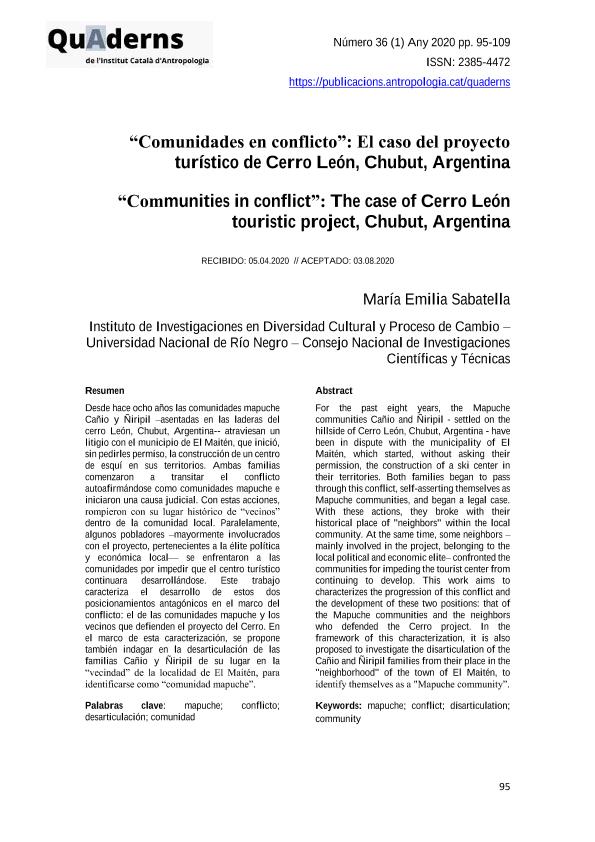Mostrar el registro sencillo del ítem
dc.contributor.author
Sabatella, María Emilia

dc.date.available
2021-03-04T17:18:17Z
dc.date.issued
2020-11
dc.identifier.citation
Sabatella, María Emilia; Comunidades en conflicto: El caso del proyecto turístico de Cerro León, Chubut, Argentina; Institut Català d'Antropologia; Quaderns; 36; 1; 11-2020; 95-109
dc.identifier.issn
0211-5557
dc.identifier.uri
http://hdl.handle.net/11336/127467
dc.description.abstract
Desde hace ocho años las comunidades mapuche Cañio y Ñiripil –asentadas en las laderas del cerro León, Chubut, Argentina--atraviesan un litigio con el municipio de El Maitén, que inició, sin pedirles permiso, la construcción de un centro de esquí en sus territorios. Ambas familias comenzaron a transitar el conflicto autoafirmándose como comunidades mapuche e iniciaron una causa judicial. Con estas acciones, rompieron con su lugar histórico de “vecinos” dentro de la comunidad local. Paralelamente, algunos pobladores –mayormente involucrados con el proyecto, pertenecientes a la élite política y económica local—se enfrentaron a las comunidades por impedir que el centro turístico continuara desarrollándose. Este trabajo caracteriza el desarrollo de estos dos posicionamientos antagónicos en el marco del conflicto: el de las comunidades mapuche y los vecinos que defienden el proyecto del Cerro. En el marco de esta caracterización, se propone también indagar en la desarticulación de las familias Cañio y Ñiripil de su lugar en la “vecindad” de la localidad de El Maitén, para identificarse como “comunidad mapuche”.
dc.description.abstract
For the past eight years, the Mapuche communities Cañio and Ñiripil -settled on the hillside of Cerro León, Chubut, Argentina -have been in dispute with the municipality of El Maitén, which started, without asking their permission, the construction of a ski center in their territories. Both families began to pass through this conflict, self-asserting themselves as Mapuche communities, and began a legal case. With these actions, they broke with their historical place of "neighbors"within the local community. At the same time, some neighbors –mainly involved in the project, belonging to the local political and economic elite–confronted the communities for impeding the tourist center from continuing to develop. This work aims to characterizes the progression of this conflict and the development of these two positions: that of the Mapuche communities and the neighbors who defended the Cerro project. In the framework of this characterization, it is also proposed to investigate the disarticulation of the Cañio and Ñiripil families from their place in the "neighborhood" of the town of El Maitén, to identify themselves as a "Mapuche community”.
dc.format
application/pdf
dc.language.iso
spa
dc.publisher
Institut Català d'Antropologia
dc.rights
info:eu-repo/semantics/openAccess
dc.rights.uri
https://creativecommons.org/licenses/by-nc-sa/2.5/ar/
dc.subject
MAPUCHE
dc.subject
CONFLICTO
dc.subject
DESARTICULACIÓN
dc.subject
COMUNIDAD
dc.subject.classification
Antropología, Etnología

dc.subject.classification
Sociología

dc.subject.classification
CIENCIAS SOCIALES

dc.title
Comunidades en conflicto: El caso del proyecto turístico de Cerro León, Chubut, Argentina
dc.title
“Communities in conflict”: The case of Cerro León touristic project, Chubut, Argentina
dc.type
info:eu-repo/semantics/article
dc.type
info:ar-repo/semantics/artículo
dc.type
info:eu-repo/semantics/publishedVersion
dc.date.updated
2020-12-04T19:54:51Z
dc.identifier.eissn
2385-4472
dc.journal.volume
36
dc.journal.number
1
dc.journal.pagination
95-109
dc.journal.pais
España

dc.journal.ciudad
Barcelona
dc.description.fil
Fil: Sabatella, María Emilia. Consejo Nacional de Investigaciones Científicas y Técnicas. Centro Científico Tecnológico Conicet - Patagonia Norte. Instituto de Investigaciones en Diversidad Cultural y Procesos de Cambio. Universidad Nacional de Río Negro. Instituto de Investigaciones en Diversidad Cultural y Procesos de Cambio; Argentina
dc.journal.title
Quaderns
dc.relation.alternativeid
info:eu-repo/semantics/altIdentifier/url/https://publicacions.antropologia.cat/quaderns/article/view/235/
Archivos asociados
